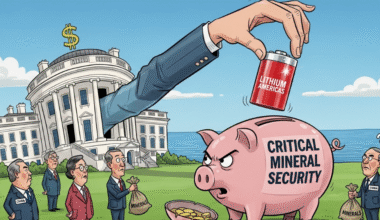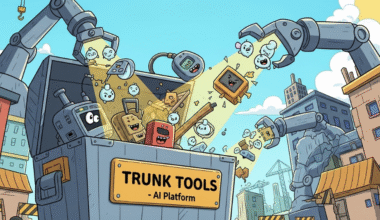Stock Symbol: USAR | Current Price: ~$32.61 (October 2025) |
NOT FINANCIAL ADVICE
USA Rare Earth has officially evolved from “that startup mining company nobody heard of” to “that company the White House keeps calling about national security.” With a market capitalization approaching $3.7 billion despite zero commercial revenue, USAR is proving that sometimes the most valuable thing you can mine isn’t what’s in the ground—it’s what Washington desperately needs you to pull out of it. The company just acquired Britain’s only ex-China rare earth metals producer for $100 million while simultaneously appointing a former Siemens USA CEO and confirming “close communication” with the Trump administration, because apparently building America’s first mine-to-magnet supply chain wasn’t ambitious enough without adding geopolitical intrigue. It’s like watching someone turn a West Texas mountain into a weapon against Chinese monopoly, except the mountain contains 16 rare earth elements and the weapon is called “supply chain independence.”
The Mine-to-Magnet Revolution: From Concept to (Almost) Reality
USAR’s transformational acquisition of Less Common Metals marks the transition from “we have a plan” to “we actually control the critical midstream bottleneck.” The company is targeting nothing less than establishing the Western world’s only complete mine-to-magnet supply chain, which is either incredibly strategic or incredibly optimistic, depending on your tolerance for execution risk in pre-revenue mining ventures.
The LCM acquisition delivers immediate credibility that typical mining startups spend decades trying to achieve. This 67,000-square-foot facility in Cheshire, UK, has been producing rare earth metals and alloys for over 30 years, serving defense contractors, automakers, and magnet manufacturers across the US, UK, France, Germany, Japan, and Taiwan. These aren’t aspirational customers—they’re actual paying clients buying samarium cobalt, neodymium-praseodymium, dysprosium, terbium, and other materials that sound like Periodic Table deep cuts but power everything from F-35 fighter jets to Tesla motors.
The strategic value becomes clear when you understand the supply chain chokepoint. China controls approximately 60% of global rare earth mining, 85% of rare earth oxide refining, and 90% of rare earth magnet manufacturing. But midstream metal and alloy production? That’s where LCM operates, and it’s the only proven ex-China producer operating at commercial scale. USAR just bought the linchpin, the essential missing piece that transforms Round Top’s Texas dirt and Stillwater’s Oklahoma facility from disconnected projects into an integrated supply chain that can actually compete.
The platform features enhanced sustainability through LCM’s ability to process recycled rare earth oxides, meaning USAR can reuse end-of-life magnets and manufacturing swarf. It’s like having a digital workforce that never calls in sick, except instead of software agents, it’s a closed-loop materials system that turns magnet waste back into magnet feedstock while simultaneously reducing dependence on Chinese imports.
Financial Performance: The Pre-Revenue Paradox
USAR’s financial story tells the tale of a company that knows how to raise capital despite burning through it at an impressive rate. The company reported negative $100 million in annual losses with essentially zero revenue, yet somehow convinced investors to provide a $125 million equity investment at $15 per share while simultaneously paying $100 million cash plus 6.74 million shares for LCM.
Current market capitalization sits at approximately $3.7 billion, which in traditional valuation terms translates to “investors are pricing in either perfect execution or government bailout, possibly both.” The stock has surged 184% year-to-date through October 2025, demonstrating market enthusiasm that would make even the most aggressive growth investor pause to check their assumptions.
Analysts don’t expect profitability before 2028, creating a fascinating investment dynamic where the company must execute flawlessly on mining, processing, and manufacturing while simultaneously securing government contracts or equity investments to fund operations until revenue materializes. The recent $125 million raise addressed previous “going concern” doubts disclosed in Q3 2025 financials, providing essential operating runway but also highlighting the capital intensity of building an entire supply chain from scratch.
The LCM acquisition changes the revenue trajectory by adding immediate cash flow from an established business rather than waiting years for Round Top mining and Oklahoma magnet production to reach commercial scale. This shortens the path to viability while demonstrating to Washington that USAR can actually deliver products, not just PowerPoint presentations about future capabilities.
The Strategic Asset Play: Round Top and Government Relations
While competitors scramble to secure rare earth supplies, USAR controls mining rights to Round Top Mountain in West Texas—the largest heavy rare earth deposit in the United States. The site contains 16 of 17 rare earth elements plus lithium, beryllium, uranium, and other critical minerals deemed essential to US national security. It’s not just a mining project; it’s a strategic asset that makes USAR impossible to ignore in any serious conversation about domestic supply chain security.
Round Top’s 2019 preliminary economic assessment projected 2,212 tonnes of rare earth oxide annual production from a 7.3 million tonne per annum operation, with a 16-month payback period on $350 million initial capital investment. The deposit contains an estimated 80 million tons of total rare earth elements plus yttrium, accessible through open-pit mining and heap leaching rather than complex underground operations. Location 85 miles from El Paso with existing highway access and proximity to rail, power, and natural gas infrastructure means this isn’t some remote wilderness extraction fantasy—it’s a developable resource.
But the real competitive advantage isn’t geological—it’s political. New CEO Barbara Humpton’s confirmation that USAR maintains “close communication” with the White House triggered a 23% single-day stock surge and $700 million market cap increase. Her background leading Siemens USA, serving on the Federal Reserve Bank of Richmond board, and chairing the Center for Strategic and Budgetary Assessments positions her perfectly to navigate the intersection of industrial capability and government procurement.
The precedent is clear. In July 2025, the Department of Defense invested $400 million in MP Materials via preferred equity, making DoD the largest shareholder while establishing a 10-year price floor of $110 per kilogram for NdPr products. The Department of Energy restructured Lithium Americas’ financing with 5% equity via warrants tied to a $2.23 billion loan. Critical Metals is negotiating conversion of a $50 million Defense Production Act grant into equity for its Greenland project. The Trump administration is directly investing in the metals sector, and USAR sits at the intersection of every strategic priority: domestic production, China competition, defense applications, and clean energy supply chains.
Execution Risk: Promise vs. Production Reality
USAR’s biggest risk remains the gap between strategic positioning and operational delivery. The company must successfully integrate a 30-year-old UK metals facility, advance Texas mining operations from exploration to production, ramp Oklahoma magnet manufacturing from first samples to 5,000-ton annual capacity, and secure government contracts or equity investment to fund all of this before capital runs out or investor patience expires.
Competition intensifies from both established players and new entrants. MP Materials already produces rare earth concentrate and separated oxides at Mountain Pass, California, with government backing and operating revenue. Lynas Rare Earths operates globally with established processing facilities. USAR must prove that its integrated mine-to-magnet strategy delivers better economics and security of supply than competitors’ focused approaches, while simultaneously demonstrating manufacturing quality that meets aerospace and defense specifications.
The enterprise sales cycle for defense and automotive customers creates natural delays between capability demonstration and revenue recognition. Military qualification processes can take years, requiring extensive testing and validation before a single magnet gets purchased. Success depends on USAR’s ability to demonstrate not just technical capability but also production consistency, quality control, and supply reliability at the exact moment when customers are evaluating alternatives to Chinese suppliers.
China’s response to US reshoring efforts adds another layer of uncertainty. Beijing just announced new export controls requiring government approval for products containing rare earth metals worth 0.1% or more of goods’ value, plus licensing requirements for anyone using Chinese extraction, refining, or recycling technology. These restrictions simultaneously validate USAR’s strategic importance while highlighting the difficulty of competing against a vertically integrated state-backed industry that’s spent decades optimizing costs and capturing markets.
The Platform Play: Mine, Metal, Magnet
USAR’s integrated approach creates switching costs and competitive moats that compound as the company brings each piece online. Round Top provides feedstock security with domestic mining that eliminates geopolitical supply risk. LCM delivers midstream metal and alloy production that transforms raw materials into magnet-ready inputs while serving existing customers across defense and industrial applications. The Stillwater, Oklahoma facility targets 5,000 tonnes of annual sintered neodymium magnet capacity, completing the value chain from ore to finished product.
The integration enables capabilities that standalone operators cannot match. USAR can optimize the entire process from mine planning through final magnet specifications based on customer requirements rather than accepting whatever Chinese suppliers offer. The company can process recycled materials, creating a sustainable closed-loop system while accessing alternative low-cost feedstock. Most importantly, USAR can guarantee supply to customers who face existential risk if Chinese exports get restricted or weaponized during geopolitical tensions.
Government relationships extend beyond potential equity investments to include procurement contracts, research partnerships, and strategic stockpiling agreements. The DoD needs domestic magnet supplies for everything from missile guidance systems to electric propulsion. The Department of Energy requires rare earths for wind turbines and grid infrastructure. Automotive manufacturers face growing pressure to secure non-Chinese supply chains for electric vehicle motors. USAR positions itself as the solution to all these problems simultaneously, creating multiple paths to commercial success.
Investment Reality Check: The National Security Bet
Based on USAR’s transformation from mining exploration to integrated supply chain operator, expanding government support for domestic critical minerals, and unique positioning as the only Western mine-to-magnet player, the company presents a high-risk, high-reward investment opportunity with significant execution challenges and equally significant strategic value.
Key catalysts include government equity investment announcements, LCM integration success and revenue contribution, Round Top mining permits and development timeline, Oklahoma facility production ramp and customer qualification, and long-term supply contracts with defense or automotive customers. Wall Street analysts maintain price targets ranging from $15 to $40 per share, reflecting both the execution risk and the transformational potential if USAR delivers on its strategic vision.
Analyst targets diverge dramatically because this isn’t a traditional mining investment—it’s a bet on whether Washington will pay whatever it takes to break China’s rare earth monopoly, and whether USAR can execute the plan before capital or patience runs out. Roth Capital recently doubled its price target to $40, citing progress toward establishing an alternative end-to-end supply chain based outside China. Canaccord Genuity maintains a $22 target. The average sits around $19, below the current trading price, suggesting either analysts haven’t caught up to recent developments or the market has gotten ahead of fundamentals.
The risk-reward profile favors aggressive investors who understand that USAR isn’t mining rare earths—they’re mining government desperation to secure strategic materials. The company has successfully positioned itself at the exact intersection of multiple Washington priorities while acquiring real assets and capabilities that demonstrate commitment beyond typical junior mining stock promotion.
For investors seeking exposure to the rare earth supply chain revolution through a company with actual assets, government relationships, and a credible path to commercial production, USAR represents the ultimate national security infrastructure play. They’ve transformed from a speculative exploration company to the Western world’s only integrated rare earth operator, and apparently that’s just the opening act for what happens when China’s export restrictions meet America’s determination to rebuild domestic manufacturing.
Disclaimer: This analysis contains references to geopolitical tensions and mining ventures and should not be considered personalized investment advice. Past performance does not guarantee future results, though USAR’s 184% year-to-date gain suggests investors believe the mine-to-magnet strategy could actually work. The company produces no meaningful revenue and won’t be profitable until 2028 at the earliest, making this a highly speculative investment suitable only for aggressive investors with high risk tolerance. Consult with a qualified financial advisor who hopefully understands both rare earth metallurgy and Washington’s willingness to subsidize strategic industries.
Last Updated: October 2025
Next Review: January 2026


